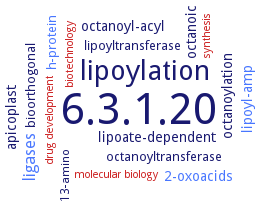6.3.1.20: lipoate-protein ligase
This is an abbreviated version!
For detailed information about lipoate-protein ligase, go to the full flat file.

Word Map on EC 6.3.1.20 
-
6.3.1.20
-
lipoylation
-
ligases
-
octanoyl-acyl
-
lipoate-dependent
-
apicoplast
-
octanoylation
-
2-oxoacids
-
lipoyl-amp
-
octanoic
-
bioorthogonal
-
lipoyltransferase
-
h-protein
-
octanoyltransferase
-
13-amino
-
biotechnology
-
synthesis
-
molecular biology
-
drug development
- 6.3.1.20
-
lipoylation
- ligases
-
octanoyl-acyl
-
lipoate-dependent
- apicoplast
-
octanoylation
- 2-oxoacids
- lipoyl-amp
-
octanoic
-
bioorthogonal
- lipoyltransferase
- h-protein
-
octanoyltransferase
-
13-amino
- biotechnology
- synthesis
- molecular biology
- drug development
Reaction
Synonyms
CTD, EC 2.7.7.63, LIP3, LipB, LipL1, lipoate ligase, lipoate ligase like protein, lipoate protein ligase, lipoate protein ligase B, lipoate-bound lipoate ligase 1, lipoate-protein ligase, lipoate-protein ligase A, lipoic acid ligase, lipoic acid ligase A, lipoic acid protein ligase, lipoic acid protein ligase A1, lipoyl ligase, lipoyl-protein ligase A, LPLA, LplA-LplB complex, LplA1, LplA1Ct, Lpla2, LplB, Oryza s. lipoate-protein ligase A, OsLPLA, PfLipL1
ECTree
Advanced search results
Crystallization
Crystallization on EC 6.3.1.20 - lipoate-protein ligase
Please wait a moment until all data is loaded. This message will disappear when all data is loaded.
structural models of LplA1 and LplA2 based on Escherichia coli (PDB: 1X2H) and Streptococcus pneumoniae (PDB: 1VQZ) LplA proteins, conserved lipoyl-AMP binding pocket, LplA1: regions of clustered negatively charged residues, overall electrostatic potential of -13, LplA2: overall electrostatic potential of -5
-
structural comparison of lipoate-protein ligase with cysteine/lysine dyad acyltransferase LipB shows conserved structural and sequence active-site features, but 4-phosphopantheine-bound octanoic acid recognition is a specific property of cysteine/lysine dyad acyltransferase
-
purified recombinant lipoyl-PfLipL1D243-279 complex, mixing of 0.001 ml of 5 mg/ml protein, 1.2 mol equiv of lipoate, and excess ATP with 0.001 ml of reservoir solution containing 100 mM HEPES, pH 7.0, 1.5 M (NH4)2SO4, and 20% ethylene glycol, 20°C, method optimization, X-ray diffraction structure determination and analysis at 2.32 A resolution
as apo form, in complex with ATP, and as lipoyl-AMP-complex. Lipoyl-AMP is bound deeply in the bifurcated pocket and adopts a U-shaped conformation


 results (
results ( results (
results ( top
top





